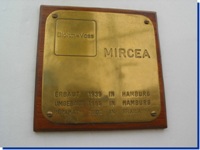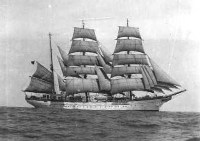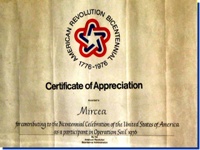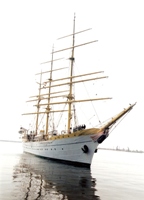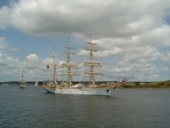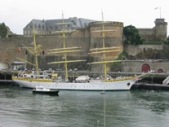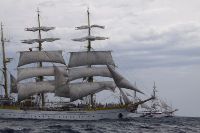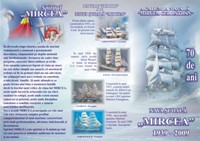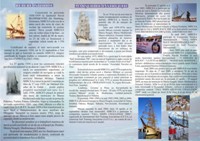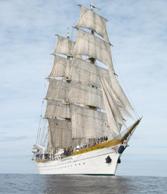
Training Ship "Mircea"
Built between 1938-1939 at the "Blohm und Woss" Shipyard in Hamburg, Germany, "Mircea" is the fourth ship from a series of five of the same type built in the same shipyard , being a sister with "Eagle"(e.g. Horst Wessel) - U.S.A., "Gorch Foch I" (e.g. Tovarisch, e.g. Gorch Foch - ship museum) - Germany, "Gorch Foch II" - Germany, "Sagres" (e.g Albert Leo Schlageter)- Portugal.
Training Ship "Mircea" is a sailing - ship, A-class, bark type, with three masts, with a height of 44 meters, with 23 mainsails that sum up a total sail surface of 1750 square meters.
The birth certificate of the new training ship was signed on the 26th of January 1938 and on the 22nd of September was water launched and baptized with the name of "Mircea", choice justified by the rich tradition and reputation of her predecessor.
The name comes from the well-known leader, Mircea the Old , that led the Romanian Country between 1386-1418 and under whose leadership the local navigation and commerce practiced on sea, knew a great development, the Romanian vessels were sailing, even from those times, not only in the Black Sea but in the Egee Sea and Mediterranean Sea too, fact that gave him the name of "Leader until the Great Sea".
The ship has at the bow, under the bowsprit a galleon, representing the leader dressed up in a blue shirt, a red cloak and wearing his crown, symbol of his reign.
The birth certificate of the new training ship was signed on the 26th of January 1938 and on the 22nd of September was water launched and baptized with the name of "Mircea", choice justified by the rich tradition and reputation of her predecessor.
The name comes from the well-known leader, Mircea the Old , that led the Romanian Country between 1386-1418 and under whose leadership the local navigation and commerce practiced on sea, knew a great development, the Romanian vessels were sailing, even from those times, not only in the Black Sea but in the Egee Sea and Mediterranean Sea too, fact that gave him the name of "Leader until the Great Sea".
The ship has at the bow, under the bowsprit a galleon, representing the leader dressed up in a blue shirt, a red cloak and wearing his crown, symbol of his reign.
On the 27th the of April 1939, it took place the ceremony of raising the national flag and on the 1st of May 1939, "Mircea" a ship with superior characteristics, that assured improved conditions of navigation and life onboard, entered the Military Navy Service.
"Mircea" entered Constanta Harbor on the 17th of May 1939, being greeted by officials, by the ships that were present in the Harbor, among which there was also the old brig brought from Galati –to pass the relay of navy training of the new ship.
On the 3 rd of July 1939, "Mircea" departs on its first training march, in the Mediterranean Sea, where it makes calls in Palermo, Toulon, Palma, Gibraltar, Alger and Alexandria Harbors.
"Mircea" entered Constanta Harbor on the 17th of May 1939, being greeted by officials, by the ships that were present in the Harbor, among which there was also the old brig brought from Galati –to pass the relay of navy training of the new ship.
On the 3 rd of July 1939, "Mircea" departs on its first training march, in the Mediterranean Sea, where it makes calls in Palermo, Toulon, Palma, Gibraltar, Alger and Alexandria Harbors.
The last call of the march that planned visits in Syria, Cyprus and the Greek Islands was cancelled starting with the German Attack against Poland.
So, on the 3rd of September 1939, "Mircea" entered Constanta Harbor and docked in the military berth.
The starting of the Second World War, meant for Training Ship "Mircea" the beginning of a long period of over 25 years, in which it didn’t perform any training marches and it didn’t" represent the Military Navy and Romania outside the Black Sea.
The management of the Military Navy decided that for Mircea’s sake it had to be taken on the 19th of February 1941, to Braila, on Arapu Channel. There it stationed until the summer of 1944, continuing to be used as a training ship.
At the beginning of September 1944, Training Ship "Mircea" together with some other Romanian vessels, were taken over by the Soviets as a capture and placed in their personal fleet at the Black Sea.
As a result of the various interventions of the Romanian authorities, the Soviet’s authorities decided to give back to Romania, the training ship. So, 2 years later, on the 27th of May, 1946, in Constanta Harbor it took place the ceremony of taking back the Training Ship "Mircea" from the Soviet crew and its replacement in the Romanian Navy.
At the Restitution Ceremony from Romania’s side it took part: King Michael the 1st, members of the government, representatives of the army and of the Military Navy, superior officers as well as a large public.
Between 1946-1947, the ship suffered some fixings, predominantly at the masting.
The training marches started again in 1947 with short voyages in the Black Sea. In September 1948, on the occasion of a put to sea, "Mircea" was surprised by an 8th grade storm, being forced to stop for 3 days and 3 nights but the good training and the courage of the seamen were the facts that dominated the bringing back of the ship in Constanta Harbor.
The ship and the crew faced between 1951-1953 other strong, furious storms. "Mircea" performed training marches across the Black Sea shore, until 1959, when there was taken into consideration the problem of reducing the military forces, including the number of some vessels. "Mircea" was included in the category of the ones that had to be out of function.
At the intervention of some responsible officers from the Military Navy, the vessel was saved by being transferred in another unit and transformed in the basis-ship of auxiliary divisional ships in Mangalia.
In 1963, as a result of some positive regulations between the Government of Romania and of the U.S.A., on the address of the country’s leadership came an invitation for "Mircea" from the President of the U.S.A. John Fitzgerald Kennedy, to visit American Harbors and to take part in a series of ceremonies.
The invitation, although it was not honored, however it drew the attention to the First Secretary of the Romanian Party, Gheorghe Gheorghiu-Dej. A year later, in 1964, the Military Navy Superintendent, Vice-Admiral Martes Grigore had a saving idea and ordered that "Mircea" to be placed in the device of military vessels that took part at the celebration of the Navy Day. On this occasion, it was decided that "Mircea" to be framed and upgraded in order to take back its unique place of a training ship and of representation.
After analyzing the possibilities of performing the capital fixing and upgrading of which "Mircea" needed at the Military Navy Headquarters and at the Armed Forces Ministry level, it was taken into consideration the best solution and that was to contact the builder on the shipyard "Blohm und Woss" in Hamburg, so that together with the German specialists to make an analysis and evaluation of the sailing-ship status and of the repairings that had to be done.
In October 1964, "Mircea" was brought from Mangalia to Constanta Harbor, where the German technicians together with the officers from the Technical Department of the Military Navy inspected the vessel and prepared the list of works and the estimation list, too.
Until the concluding of the papers and signing of the contract, the Military Navy Headquarter decided to board on "Mircea" a small crew for the ship’s preparing regarding the performance of the march in Hamburg.
There were also prepared the two tugs, RM 101, NS 116, built for towing missions. Agreeing with the Minister of Transports, both "Mircea" and the tow tugs sailed under logo of "NAVROM". The tugs were recorded in the Navy Register under the names of "VITEAZUL", RM 101 and "VOINICUL", NS 116, and on the funnels it was applied the NAVROM logo. The functions that the crew had to do were identical with the ones from the Romanian Merchant Marine. Such decision was taken in order to avoid the formalities and complications that might have appeared if they sailed as military ships.
The departure was made on the 12th of October 1965, pretty late, in a period of time when storms were quite frequent in the Black Sea, in the Mediterranean Sea, but especially in the Atlantic Ocean. This reality fact created enough worries to the captains and to the crews of the three vessels.
Because of the unfavorable weather, the convoy stayed at shelter at Canakkle in Turkey, in La Valetta Harbor in Malta and at Gibraltar from where on the 7th of November 1965, started the confrontation with the Atlantic Ocean. After a few days of marching, the unfavorable weather forced the convoy to enter the Tejo River, in Lisbon Harbor from Portugal.
On the 22nd of November, it was decided to go on with the march.
After more than one month from the departure from Constanta Harbor, the convoy managed to sail only half road.
In this way, on the 24th of November 1965 on a calm ocean and clear sky, it began the passing of the Biscaya Golf. For "Mircea" and its crew, it was the beginning of some dramatic moments. In the morning of the 25th of November, the wing began to blow, it started to rain and the ship heeled over 35 degrees in both boards. After 8 o’clock the cannonball sheet broke and fell over the bridge and broke the railing on a length of six meters. "VITEAZUL" eased the engine of the tug and "Mircea" is pulled only by "VOINICUL" on an ocean with an 8th grade storm. On the 26th of November, the storm became extremely strong and although both tugs were pulling with all their strength, "Mircea" stayed motionless. The convoy is pushed at about 300-400 meters near the big buoy that signaled the maximum limit of approaching the bed rocks from Chausse de Sein.
Because of the strong waves and wind that overcame 120 km/s, the rug broke down and "Mircea" without propulsion remained alone in the inferno. "VOINICUL" tried once again to take in tow but it was impossible.
The two tugs were taken away by the hurricane and taken far away offshore.
"Mircea" throws the anchor from the starboard that harrowed on the rocky bottom towards the dangerous area of the buoy.
Then it was thrown the anchor from the larboard and after it harrowed for a while, it caught the buoy’s mooring system. The ship started the fight with the 16 meters tall buoy. A part of the masting was broken, the boat from the larboard broke, and the buoy’s spurs caused in shell, in the bow section 9(nine) water holes. It was launched the S.O.S. call, and in the same time it started the fight for covering the water holes. The S.O.S. call was received by the authorities of the French Brest Harbor, that sent in the area 2(two) rescuing vessels. Until the arrival of the rescuing vessels, "Mircea" approached to the Norwegian Cargo CONRAD, that tried but with no luck to pass the towrope. By morning, on the 27th of November, the French tug A-676 IMPLACABLE arrived next to "Mircea" and tried for many times to pass the towrope. In the same day, at 15:00 o’clock, it arrived a second French tug A-668 RINOGERUS, but because of the storm that grew in intensity, the passing of the towrope was impossible. Only on the 28th of November, at about 8 o’clock, the tug A-668 RINOGERUS succeeded in passing the towrope and so in this way "Mircea" was tugged in Brest Harbor.
The two Romanian tugs passed through difficult situations, too. "VOINICUL" ship whose helm broke down, was passed the towrope by savior "LUDOVIC JEGO" and brought in Brest Harbor and "VITEAZUL" arrived alone in the wake of a French Military Vessel.
The storm that Training-ship "Mircea" faced, was the most difficult one in its entire activity. Through its special nautical qualities, "Mircea" saved itself and it also saved the life of its crew. "Mircea" was not part of the 40 ships that were sank by the storm, one of the most powerful registered in the last 20 years, in that particular area.
On the 6th of January 1966, the convoy continued its way towards Hamburg, but because of the unfavorable weather, on the 8th of November it shelters in Dover Harbor in the south of England. After 8 days of stationing, it continued its march, and on the 17th of January it entered on the Elba.
On the 19th of January 1966, "Mircea" brig came into dock on one of the harbor’s docks that built it, for works of restoration. On the 28th of January, the two tugs, VOINICUL and VITEAZUL, with their mission accomplished left for the country where they arrived after 27 days of marching.
The special sailor deed of the 3 crews was mentioned in the collective memory and tradition of the Romanian Navy, being close to the epic story from 1888, of the first "Mircea" brig, another reason of great consideration for the ones who valued more their capacity for profession, instead of their own lives. On the 24th of August 1966, "Mircea" suffered fixings, works of endowment and upgrading. Upgrading work were realized both at the ship’s hull, masting and rig and at all onboard equipments. There were installed strong lamps in corresponding positions so that to allow safe work in the masting during night.
The capstans and the winches were upgraded and it was assured their electric functioning.
The anchor gear equipment was also upgraded, and the onboard boats were replaced with boats 10+1 from mahogany, and entered in the endowment of the motorboat and slip’s boat. There were belayed at the established places through project the life rafts corresponding as number with the standards of the German Navy Register. As utilities for logistics, the ship’s provision room was endowed with holding freezer of great capacity, there were set onboard washing machines, the barrack equipage for the crew and staff officers, centrifugal draining machine of great capacity, ironing machine with calender, fridges for squares, buffets and kitchens.
The ship’s kitchen was equipped with electric hobs of great power and cooking boilers of great capacity, oven for bakery, vegetable cutting machine and drinking water machine for the crew provided with refrigerator. Onboard it was installed a machine for mineral water preparing.
The ship disposed of adequate areas for tailoring, shoemaker’s trade and hairdresser and not least library and photo laboratory.
The furniture and endowments both at the level of barrack equipage and under the quarterdeck were completely restored, the ship having squares for the petty officers, midshipmen, cabins for officers and officials as well as two protocol apartments. At the ship’s aft under the quarterdeck, it was restored in special conditions the ship’s saloon where it took place over time numerous protocol activities onboard being present presidents and personalities of the political life and military representatives of the highest rank.
The ship’s infirmary was also very well equipped having all the facilities for assuring including surgeries, possessing two anti-roll beds in the adjacent infirmary ward.
At the engine part, the most important restoring was represented by the replacing of the main engine with one of new generation. This one allows the ship even in present a good handling and a speed of about 10 knots. There were set four groups diesel-generators of different powers with automatic panel for hot water onboard and for heating, salt settler, air conditioning for the ship’s hall, protocol apartments and captain’s cabin house water supply plant of freshwater and saltwater, advanced trim and bilge pumps.
The first reception march took place on the 20th of September 1966 in the North Sea, and on the 6th of November it was signed the reception note.
The German Navy Register gave Training-ship "Mircea" at the going out of the shipyard the class Malta Cross 100 A4E with the freeboard of 2.27 meters that proved that the sailing-ship could sail without restrictions in the sea or in the ocean.
On the 10th on October 1966, under the command of Captain Alexandru Hirjan, "Mircea" started its journey towards the country, reaching Constanta Harbor on the 7th of November 1966.
The "Mircea" spirit, reborn , was taken over by a new generation of Military Navy and Merchant Navy officers.
Starting with 1967, Training-ship "Mircea", performed international marches of short and long periods of time until 1967, when it became the first ship in the Military Navy that performed the crossing of the Atlantic Ocean to represent Romania at the most important event that the American people prepared to celebrate on the 4th of July 1976 and that was the Independence Bicentennial.
On the 8th of September 1975, the Department of the Navy Forces of the United States of America addressed to General Ion Coman, who accomplished at that period of time all functions of First Deputy of the Ministry of National Defense and Chief of the Great Staff, a letter I which he specified that he "has the pleasure to invite the Romanian Military Navy to take part together with the Military Navy Forces of the United States to an international parade that would take place at New York on the 4th of July 1976. The parade would celebrate the 200th anniversary of the United States Independence. The celebration of this bicentennial event that would be organized together with "Operation Sail 1976", will recognize the importance of oceans in the history and future of the United States and will celebrate the common brotherhood of all sailors of all nations.
The starting of the Second World War, meant for Training Ship "Mircea" the beginning of a long period of over 25 years, in which it didn’t perform any training marches and it didn’t" represent the Military Navy and Romania outside the Black Sea.
The management of the Military Navy decided that for Mircea’s sake it had to be taken on the 19th of February 1941, to Braila, on Arapu Channel. There it stationed until the summer of 1944, continuing to be used as a training ship.
At the beginning of September 1944, Training Ship "Mircea" together with some other Romanian vessels, were taken over by the Soviets as a capture and placed in their personal fleet at the Black Sea.
As a result of the various interventions of the Romanian authorities, the Soviet’s authorities decided to give back to Romania, the training ship. So, 2 years later, on the 27th of May, 1946, in Constanta Harbor it took place the ceremony of taking back the Training Ship "Mircea" from the Soviet crew and its replacement in the Romanian Navy.
At the Restitution Ceremony from Romania’s side it took part: King Michael the 1st, members of the government, representatives of the army and of the Military Navy, superior officers as well as a large public.
Between 1946-1947, the ship suffered some fixings, predominantly at the masting.
The training marches started again in 1947 with short voyages in the Black Sea. In September 1948, on the occasion of a put to sea, "Mircea" was surprised by an 8th grade storm, being forced to stop for 3 days and 3 nights but the good training and the courage of the seamen were the facts that dominated the bringing back of the ship in Constanta Harbor.
The ship and the crew faced between 1951-1953 other strong, furious storms. "Mircea" performed training marches across the Black Sea shore, until 1959, when there was taken into consideration the problem of reducing the military forces, including the number of some vessels. "Mircea" was included in the category of the ones that had to be out of function.
At the intervention of some responsible officers from the Military Navy, the vessel was saved by being transferred in another unit and transformed in the basis-ship of auxiliary divisional ships in Mangalia.
In 1963, as a result of some positive regulations between the Government of Romania and of the U.S.A., on the address of the country’s leadership came an invitation for "Mircea" from the President of the U.S.A. John Fitzgerald Kennedy, to visit American Harbors and to take part in a series of ceremonies.
The invitation, although it was not honored, however it drew the attention to the First Secretary of the Romanian Party, Gheorghe Gheorghiu-Dej. A year later, in 1964, the Military Navy Superintendent, Vice-Admiral Martes Grigore had a saving idea and ordered that "Mircea" to be placed in the device of military vessels that took part at the celebration of the Navy Day. On this occasion, it was decided that "Mircea" to be framed and upgraded in order to take back its unique place of a training ship and of representation.
After analyzing the possibilities of performing the capital fixing and upgrading of which "Mircea" needed at the Military Navy Headquarters and at the Armed Forces Ministry level, it was taken into consideration the best solution and that was to contact the builder on the shipyard "Blohm und Woss" in Hamburg, so that together with the German specialists to make an analysis and evaluation of the sailing-ship status and of the repairings that had to be done.
In October 1964, "Mircea" was brought from Mangalia to Constanta Harbor, where the German technicians together with the officers from the Technical Department of the Military Navy inspected the vessel and prepared the list of works and the estimation list, too.
Until the concluding of the papers and signing of the contract, the Military Navy Headquarter decided to board on "Mircea" a small crew for the ship’s preparing regarding the performance of the march in Hamburg.
There were also prepared the two tugs, RM 101, NS 116, built for towing missions. Agreeing with the Minister of Transports, both "Mircea" and the tow tugs sailed under logo of "NAVROM". The tugs were recorded in the Navy Register under the names of "VITEAZUL", RM 101 and "VOINICUL", NS 116, and on the funnels it was applied the NAVROM logo. The functions that the crew had to do were identical with the ones from the Romanian Merchant Marine. Such decision was taken in order to avoid the formalities and complications that might have appeared if they sailed as military ships.
The departure was made on the 12th of October 1965, pretty late, in a period of time when storms were quite frequent in the Black Sea, in the Mediterranean Sea, but especially in the Atlantic Ocean. This reality fact created enough worries to the captains and to the crews of the three vessels.
Because of the unfavorable weather, the convoy stayed at shelter at Canakkle in Turkey, in La Valetta Harbor in Malta and at Gibraltar from where on the 7th of November 1965, started the confrontation with the Atlantic Ocean. After a few days of marching, the unfavorable weather forced the convoy to enter the Tejo River, in Lisbon Harbor from Portugal.
On the 22nd of November, it was decided to go on with the march.
After more than one month from the departure from Constanta Harbor, the convoy managed to sail only half road.
In this way, on the 24th of November 1965 on a calm ocean and clear sky, it began the passing of the Biscaya Golf. For "Mircea" and its crew, it was the beginning of some dramatic moments. In the morning of the 25th of November, the wing began to blow, it started to rain and the ship heeled over 35 degrees in both boards. After 8 o’clock the cannonball sheet broke and fell over the bridge and broke the railing on a length of six meters. "VITEAZUL" eased the engine of the tug and "Mircea" is pulled only by "VOINICUL" on an ocean with an 8th grade storm. On the 26th of November, the storm became extremely strong and although both tugs were pulling with all their strength, "Mircea" stayed motionless. The convoy is pushed at about 300-400 meters near the big buoy that signaled the maximum limit of approaching the bed rocks from Chausse de Sein.
Because of the strong waves and wind that overcame 120 km/s, the rug broke down and "Mircea" without propulsion remained alone in the inferno. "VOINICUL" tried once again to take in tow but it was impossible.
The two tugs were taken away by the hurricane and taken far away offshore.
"Mircea" throws the anchor from the starboard that harrowed on the rocky bottom towards the dangerous area of the buoy.
Then it was thrown the anchor from the larboard and after it harrowed for a while, it caught the buoy’s mooring system. The ship started the fight with the 16 meters tall buoy. A part of the masting was broken, the boat from the larboard broke, and the buoy’s spurs caused in shell, in the bow section 9(nine) water holes. It was launched the S.O.S. call, and in the same time it started the fight for covering the water holes. The S.O.S. call was received by the authorities of the French Brest Harbor, that sent in the area 2(two) rescuing vessels. Until the arrival of the rescuing vessels, "Mircea" approached to the Norwegian Cargo CONRAD, that tried but with no luck to pass the towrope. By morning, on the 27th of November, the French tug A-676 IMPLACABLE arrived next to "Mircea" and tried for many times to pass the towrope. In the same day, at 15:00 o’clock, it arrived a second French tug A-668 RINOGERUS, but because of the storm that grew in intensity, the passing of the towrope was impossible. Only on the 28th of November, at about 8 o’clock, the tug A-668 RINOGERUS succeeded in passing the towrope and so in this way "Mircea" was tugged in Brest Harbor.
The two Romanian tugs passed through difficult situations, too. "VOINICUL" ship whose helm broke down, was passed the towrope by savior "LUDOVIC JEGO" and brought in Brest Harbor and "VITEAZUL" arrived alone in the wake of a French Military Vessel.
The storm that Training-ship "Mircea" faced, was the most difficult one in its entire activity. Through its special nautical qualities, "Mircea" saved itself and it also saved the life of its crew. "Mircea" was not part of the 40 ships that were sank by the storm, one of the most powerful registered in the last 20 years, in that particular area.
On the 6th of January 1966, the convoy continued its way towards Hamburg, but because of the unfavorable weather, on the 8th of November it shelters in Dover Harbor in the south of England. After 8 days of stationing, it continued its march, and on the 17th of January it entered on the Elba.
On the 19th of January 1966, "Mircea" brig came into dock on one of the harbor’s docks that built it, for works of restoration. On the 28th of January, the two tugs, VOINICUL and VITEAZUL, with their mission accomplished left for the country where they arrived after 27 days of marching.
The special sailor deed of the 3 crews was mentioned in the collective memory and tradition of the Romanian Navy, being close to the epic story from 1888, of the first "Mircea" brig, another reason of great consideration for the ones who valued more their capacity for profession, instead of their own lives. On the 24th of August 1966, "Mircea" suffered fixings, works of endowment and upgrading. Upgrading work were realized both at the ship’s hull, masting and rig and at all onboard equipments. There were installed strong lamps in corresponding positions so that to allow safe work in the masting during night.
The capstans and the winches were upgraded and it was assured their electric functioning.
The anchor gear equipment was also upgraded, and the onboard boats were replaced with boats 10+1 from mahogany, and entered in the endowment of the motorboat and slip’s boat. There were belayed at the established places through project the life rafts corresponding as number with the standards of the German Navy Register. As utilities for logistics, the ship’s provision room was endowed with holding freezer of great capacity, there were set onboard washing machines, the barrack equipage for the crew and staff officers, centrifugal draining machine of great capacity, ironing machine with calender, fridges for squares, buffets and kitchens.
The ship’s kitchen was equipped with electric hobs of great power and cooking boilers of great capacity, oven for bakery, vegetable cutting machine and drinking water machine for the crew provided with refrigerator. Onboard it was installed a machine for mineral water preparing.
The ship disposed of adequate areas for tailoring, shoemaker’s trade and hairdresser and not least library and photo laboratory.
The furniture and endowments both at the level of barrack equipage and under the quarterdeck were completely restored, the ship having squares for the petty officers, midshipmen, cabins for officers and officials as well as two protocol apartments. At the ship’s aft under the quarterdeck, it was restored in special conditions the ship’s saloon where it took place over time numerous protocol activities onboard being present presidents and personalities of the political life and military representatives of the highest rank.
The ship’s infirmary was also very well equipped having all the facilities for assuring including surgeries, possessing two anti-roll beds in the adjacent infirmary ward.
At the engine part, the most important restoring was represented by the replacing of the main engine with one of new generation. This one allows the ship even in present a good handling and a speed of about 10 knots. There were set four groups diesel-generators of different powers with automatic panel for hot water onboard and for heating, salt settler, air conditioning for the ship’s hall, protocol apartments and captain’s cabin house water supply plant of freshwater and saltwater, advanced trim and bilge pumps.
The first reception march took place on the 20th of September 1966 in the North Sea, and on the 6th of November it was signed the reception note.
The German Navy Register gave Training-ship "Mircea" at the going out of the shipyard the class Malta Cross 100 A4E with the freeboard of 2.27 meters that proved that the sailing-ship could sail without restrictions in the sea or in the ocean.
On the 10th on October 1966, under the command of Captain Alexandru Hirjan, "Mircea" started its journey towards the country, reaching Constanta Harbor on the 7th of November 1966.
The "Mircea" spirit, reborn , was taken over by a new generation of Military Navy and Merchant Navy officers.
Starting with 1967, Training-ship "Mircea", performed international marches of short and long periods of time until 1967, when it became the first ship in the Military Navy that performed the crossing of the Atlantic Ocean to represent Romania at the most important event that the American people prepared to celebrate on the 4th of July 1976 and that was the Independence Bicentennial.
On the 8th of September 1975, the Department of the Navy Forces of the United States of America addressed to General Ion Coman, who accomplished at that period of time all functions of First Deputy of the Ministry of National Defense and Chief of the Great Staff, a letter I which he specified that he "has the pleasure to invite the Romanian Military Navy to take part together with the Military Navy Forces of the United States to an international parade that would take place at New York on the 4th of July 1976. The parade would celebrate the 200th anniversary of the United States Independence. The celebration of this bicentennial event that would be organized together with "Operation Sail 1976", will recognize the importance of oceans in the history and future of the United States and will celebrate the common brotherhood of all sailors of all nations.
The invitation being accepted, on the 4th of March 1976, at 10:20 o’clock, "Mircea" leaves the Constanta Harbor. The itinerary contained 12 harbors on 4 continents, and the march lasted for 6 months. "Mircea" took part at the international regatta together with 18 sailing-ships from class A-among them the sister ships: EAGLE-U.S.A., GORCH FOCK-GERMANY, TOVARISCH-UKRAINE, SAGRES II-PORTUGAL and 66 sailing-ships from class B. As recognition of the contribution at the success of the sailing-ships regatta, the American Association of the Training-ships, awarded Training-ship "Mircea" - the Merit Certificate.
Between 1977-1994, Training-ship "Mircea" performed marches in the Black Sea and the Mediterranean Sea according to the practical training plans of students but of representation too. During all this period, the ship was very well maintained by an exceptional crew, which through competence and devotion, carried the Romanian Flag on the seas and oceans of the world.
In this way, in 1979 the Romanian Sailing-ship performed a march in the Mediterranean Sea, in the Atlantic Ocean with the following port of calls: Istanbul, Livorno, Pireu; in 1980 it performed a march in the Mediterranean Sea (port of calls: Toulon, Barcelona, La Valetta). In 1986, 1987, 1988, 1990, 1993, 1994, 2003, Training-ship "Mircea" performed marches in the Black Sea (port of calls: Varna, Istanbul, Sevastopol, Odessa, Burgas, Suhumi, Novorossisk).
Time left his mark and the ship needed capital repairing and that was the reason for which between the 31st of July-the 6th of August 1994, "Mircea" performed the last training -march in the Black Sea, before it entered the shipyard. In this way, on the 4th of October 1994, "Mircea" parted for the Braila Naval Shipyard for upgrading.
The works were of very good quality but they lasted for quite a long time.
Between 1977-1994, Training-ship "Mircea" performed marches in the Black Sea and the Mediterranean Sea according to the practical training plans of students but of representation too. During all this period, the ship was very well maintained by an exceptional crew, which through competence and devotion, carried the Romanian Flag on the seas and oceans of the world.
In this way, in 1979 the Romanian Sailing-ship performed a march in the Mediterranean Sea, in the Atlantic Ocean with the following port of calls: Istanbul, Livorno, Pireu; in 1980 it performed a march in the Mediterranean Sea (port of calls: Toulon, Barcelona, La Valetta). In 1986, 1987, 1988, 1990, 1993, 1994, 2003, Training-ship "Mircea" performed marches in the Black Sea (port of calls: Varna, Istanbul, Sevastopol, Odessa, Burgas, Suhumi, Novorossisk).
Time left his mark and the ship needed capital repairing and that was the reason for which between the 31st of July-the 6th of August 1994, "Mircea" performed the last training -march in the Black Sea, before it entered the shipyard. In this way, on the 4th of October 1994, "Mircea" parted for the Braila Naval Shipyard for upgrading.
The works were of very good quality but they lasted for quite a long time.
On the 26th of April 2002, starting with 9 o’clock, in Braila Naval Shipyard took place the ceremony on the occasion of Training-ship "Mircea" leaving in the receiving test.
On the 29th of April 2002, "Mircea" arrived in Constanta Harbor, where it accosted at the embankment full of people. There could be seen admirals, generals, local officials, civilians and young students of "Mircea cel Batran" Naval Academy, admiral and officers retired and in reserve, representatives of the Romanian Naval League, who joined in the efforts of major fundraising for fixing the ship.
Starting with the same year, Training-ship "Mircea" restarted its training and representing marches both in the Black Sea and in the Mediterranean Sea and in the Atlantic Ocean.
During the 29th of July-10th of August 2003, "Mircea" performed the training march in the Black Sea and in Marmara Sea where it visited Turkey’s Naval Academy from Tuzla.
On the 29th of April 2002, "Mircea" arrived in Constanta Harbor, where it accosted at the embankment full of people. There could be seen admirals, generals, local officials, civilians and young students of "Mircea cel Batran" Naval Academy, admiral and officers retired and in reserve, representatives of the Romanian Naval League, who joined in the efforts of major fundraising for fixing the ship.
Starting with the same year, Training-ship "Mircea" restarted its training and representing marches both in the Black Sea and in the Mediterranean Sea and in the Atlantic Ocean.
During the 29th of July-10th of August 2003, "Mircea" performed the training march in the Black Sea and in Marmara Sea where it visited Turkey’s Naval Academy from Tuzla.
The march performed in 2004, between the 19th of April and the 26th of September remained memorable. The invitation received since 2002 from Senator Edward Kennedy made possible the participation of "Mircea" at the nautical competition "TALL SHIPS CHALLENGE 2004", organized by International Sail Training Associations (I.S.T.A.) and American Sail Training Association (A.S.T.A.) on the east coast of the United States of America and Canada. For 160 days, the 190 members of its crew ran 15.000 marine miles and represented Romania in 13 harbors: Cagliari, Las Palmas, Hamilton, Charleston, Baltimore, New Port, New London, Halifax, Arichat, Sydney, Brest, Cadiz, La Valleta. In comparison with the march from 1976, this one was 20 (twenty) days shorter.
The following year, there were received numerous invitations of taking part to ceremonies occasioned by different events of some countries.
Wanting to answer to many requests, in 2005 there were performed 2(two) marches. During the 21st of April and the 6th of May 2005, it took part on the west coast of Turkey to the International Maritime Festival from Marmaris Harbor, the first of this kind organized in Turkey.
It came back in the country, and on the 9th of June 2005 it parted in a training and representation march in the Mediterranean Sea, Atlantic Ocean and North Sea.
The following year, there were received numerous invitations of taking part to ceremonies occasioned by different events of some countries.
Wanting to answer to many requests, in 2005 there were performed 2(two) marches. During the 21st of April and the 6th of May 2005, it took part on the west coast of Turkey to the International Maritime Festival from Marmaris Harbor, the first of this kind organized in Turkey.
It came back in the country, and on the 9th of June 2005 it parted in a training and representation march in the Mediterranean Sea, Atlantic Ocean and North Sea.
On this occasion, it took part at the ceremonies from Zeebrugge, occasioned by the 175th anniversary of the Belgium Kingdom, in Cherbourg Harbor, at the ceremonies occasioned by France National Day from where it parted in the race of the great sailing-ships "TALL SHIPS RACE 2005", in Germany in Bremerhaven Harbor at the festival "SAIL Bremerhaven 2005" and in Holland at the festival "SAIL Amsterdam 2005". After it sailed 8876 marine miles, on the 20th of September 2005 it came back to Constanta. During the 11 port of calls in: -Palermo, Lisabona, Brugge, Cherbourg, Middlesbrough, New Castle, Fredrikstad, Bremerhaven, Amsterdam, Cartagena, Bizerte, Training-ship "Mircea" received onboard 39.000 visitors.
During the 10th of July - 10th of August 2006, Training-ship "Mircea" performed a training march in the Black Sea, making port of calls in 5 harbors river-side to the Black Sea respectively Novorossisk (the Russian Federation), Sevastopol and Odessa (Ukraine), Varna (Bulgaria), and Samsun (Turkey). Onboard the vessel, next to the Romanian cadets, there were embarked tow Turk cadets as well, to train within the International Collaboration Programmes of "Mircea cel Batran" Naval Academy with similar high education institutions.
In 2007, it was performed the 34th training march of the ship in the international seas. Unfold during the 19th of June-10th of August, in the Mediterranean Sea, "Mircea" took part to the International Nautical Competition – "TALL SHIPS RACE MEDITERRANEA 2007"-organized by SAIL TRAINING INTERNATIONAL. On this occasion, there were visited the harbors: -Pireu (Greece), Alicante and Barcelona (Spain), Toulon (France) and Genova (Italy). Next to the Romanian students there were embarked cadets from France, Germany, Holland, Denmark, Turkey, Ukraine and Croatia, for training within the International Collaboration Programmes of "Mircea cel Batran" Naval Academy with similar high education institutions.
Training-ship "Mircea" performed during the 26th of May-18th of September 2008, a training march in the Mediterranean Sea, the Atlantic Ocean, North Sea and Baltic Sea. Onboard there were embarked in different stages of the march four cadets from Ukraine, Croatia, Turkey and Belgium. "Mircea" made port of calls in 10 harbors, respectively in Cagliari, Malaga, Rouen, Brest, Rotterdam, Copenhaga, Rostock, Fowey, Lisabona and Valleta. On this occasion, training-ship "Mircea" represented the Romanian Navy Forces at many international nautical festivals, including the celebration of the semi-centennial of the sister training-ship Gorch Fock, belonging to the German Military Navy.
2009 represented for training-ship "Mircea" a very important year.
On the 17th of May, "Mircea" celebrated 70 years of existence, years that it carried with dignity and nobility, being in an exceptional technical and maintaining state, fact confirmed by the accomplishing of the nautical periplus in that particular year, during 12th of April-1st of September 2009, a training march in the Black Sea, Mediterranean Sea and Atlantic Ocean, with port of calls in Catania (Sicilia-Italy), Cadiz (Spain), Tenerife (Canare Islands-Spain), Hamilton (Bermuda Islands), Charlestone (South Carolina-U.S.A.), Boston (Mariland-U.S.A.), Ponta Delgada (Azore Islands-Portugal) and Mellila. On this occasion training-ship "Mircea" took part to the Regatta "TALL SHIPS CHALLENGE 2009", and to the "BOSTON SAIL FESTIVAL".
On the 17th of May, "Mircea" celebrated 70 years of existence, years that it carried with dignity and nobility, being in an exceptional technical and maintaining state, fact confirmed by the accomplishing of the nautical periplus in that particular year, during 12th of April-1st of September 2009, a training march in the Black Sea, Mediterranean Sea and Atlantic Ocean, with port of calls in Catania (Sicilia-Italy), Cadiz (Spain), Tenerife (Canare Islands-Spain), Hamilton (Bermuda Islands), Charlestone (South Carolina-U.S.A.), Boston (Mariland-U.S.A.), Ponta Delgada (Azore Islands-Portugal) and Mellila. On this occasion training-ship "Mircea" took part to the Regatta "TALL SHIPS CHALLENGE 2009", and to the "BOSTON SAIL FESTIVAL".
Over 70 years in which promotions of Romanian sailors performed their apprenticeship onboard "Mircea", proudly identified themselves with the training-ship, making the Romanian Navy distinct among the other types of weapons.
Onboard this ship, there were trained worthy sailors, professionals on the way without powder, facing the sea"s caprices. The crew but the cadets too that trained themselves onboard "Mircea" watched every time with great emotion and pride the country's flag waving in the heights.
No one doubts that "Mircea" is a real ambassador of the Romanian Navy Forces worldwide.
"Mircea" is not only a school of the sailor knowledge, but a bastion of forming characters too, of trust and solidarity for those who have served it for 70 years.
Onboard this ship, there were trained worthy sailors, professionals on the way without powder, facing the sea"s caprices. The crew but the cadets too that trained themselves onboard "Mircea" watched every time with great emotion and pride the country's flag waving in the heights.
No one doubts that "Mircea" is a real ambassador of the Romanian Navy Forces worldwide.
"Mircea" is not only a school of the sailor knowledge, but a bastion of forming characters too, of trust and solidarity for those who have served it for 70 years.
"I serve the navy, I serve my country! It is the unanimous thought of the crew, of the cadets that are practically learning the sailor’s secrets.
Away from the country and the dear ones, they all found in "Mircea" a great family, for good and for bad, working with solidarity and deep attachment. In this way, they always succeeded to pass over the moments of fear, eagerness and uncertainties.
It was proved with abundantly that in the over 70 years of existence, "Mircea" is a real school of courage, profession and manhood.
Away from the country and the dear ones, they all found in "Mircea" a great family, for good and for bad, working with solidarity and deep attachment. In this way, they always succeeded to pass over the moments of fear, eagerness and uncertainties.
It was proved with abundantly that in the over 70 years of existence, "Mircea" is a real school of courage, profession and manhood.

